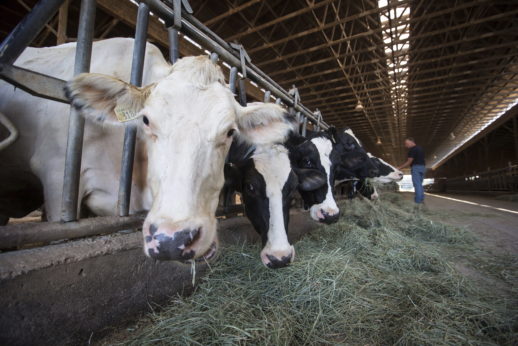
From Washington to Ottawa to Mexico City, it was all smiles and pats on the back yesterday for the new United States-Mexico-Canada Agreement, replacement for the nearly quarter-century-old NAFTA.
President Trump called it a “terrific deal,” and seemed most excited that he gets credit for renaming the continental trade regime, repeatedly spelling out the acronym—“U-S-M-C-A”—at a press conference. That’s no surprise; form always takes precedent over substance in the sales pitches of con men.
Canadian Prime Minister Justin Trudeau promised the deal will be “good for the middle class,” while outgoing Mexican President Enrique Pena Nieto said it was a “win-win-win.”
Union leaders are optimistic, too. AFL-CIO head Richard Trumka is calling USMCA a “good start” on addressing the shortcomings of NAFTA. Jerry Dias, head of Canada’s largest private sector union, Unifor, says the deal represents a “great day for Canadians.” But organized labor also remains wary; they’ve been burned before. Promises made back in the early 1990s that NAFTA would look after labor rights came to nil.
Progressive economists are considerably more cautious. The Canadian Center for Policy Alternatives’ Hadrian Mertins-Kirkwood is calling the USMCA “a mashup between the old NAFTA and the new TPP,” referring to the Trans-Pacific Partnership that Trump pulled the U.S. out of when he took office. Mark Weisbrot, at the Center for Economic and Policy Research in Washington, is lamenting that much like the old NAFTA, the new one still lacks enforceable labor and environmental standards.
They’re right to call for a closer look. While there is much to celebrate in the agreement when comparing it to what we’re getting rid of with NAFTA, the USMCA is still rooted in a model of trade that prioritizes corporate interests over those of people and the environment.

(Possible) gains for labor
Probably the most talked-about parts of the deal are those dealing with automobile origin and content requirements. With its rules increasing the percentage of U.S.-made parts required for cars sold in North America, the USMCA appears to promise more jobs for American workers in that sector. And Canadian auto workers are pleased to see that import quotas for their products entering the U.S. are, in effect, gone. (The matter of steel and aluminum tariffs remain to be settled.) The hope among auto workers in both countries is that the drive to outsource manufacturing will be slowed.
Fading away from the final agreement was the supposed hard line that the Canadian government was going to take against anti-union “right to work” laws in the U.S. that force workers to compete for lower and lower wages. It was, of course, never a serious negotiating point. As this publication warned a year ago, American workers couldn’t rely on Justin Trudeau to save them from right to work.
But the biggest potential gains for labor are those promised for Mexican workers. Nominal average Mexican wages in manufacturing are around $2.30 an hour. The USMCA will supposedly put upward pressure on that number by mandating that between 40 to 45 percent of a North American car’s parts must be produced by workers being paid $16+ an hour or risk tariffs.
Whether that eight-fold jump will translate into higher Mexican wages or just fewer Mexican auto parts factories remains to be seen (see previous paragraph on expected gains in U.S. auto parts sector). Consumers can probably expect to see fewer small, lower-priced cars and more of the Big Three automakers’ larger and more expensive models for sale.
Labor law in Mexico will likely see an updating, as the deal requires that country to guarantee its workers right to organize into unions and collectively bargain. The unions that currently exist in Mexico are mostly company-controlled, and any independent efforts by workers to set up their own unions are often met with firings or violence.
One symbolic advance is that the chapter on labor rights and enforcement is moved into the main text of the treaty, rather than being relegated to an attached “side agreement,” as was the case with the original NAFTA. The language in the labor chapter suggests a more robust and meaningful complaints process will now be available, but as with the old agreement, enforcement is going to be where the rubber hits the road. Complaints were often made under NAFTA, but penalties against companies just didn’t seem to ever happen.
As Human Rights Watch noted almost two decades ago, “agreements on labor will never work without the active support of the countries involved. In the case of NAFTA, these three countries have actually worked to minimize the impact of the labor provisions.”
U.S. agribusiness chalks up victories
Canada is increasing the share of its supply-managed dairy sector that is open to U.S. products, hitting a (not-so-) whopping 3.59 percent. While you can expect Trump to spin this as a big victory for dairy farmers in the agricultural states he and his Republican Party rely on, the even bigger winners are U.S. agribusiness corporations.
The actual percentage of the Canadian market being opened up is comparable to what was already negotiated in the earlier Trans-Pacific Partnership that Trump quit, so market share is not the most notable item. What’s really at stake is that Canadian farmers will now be forced to compete on unequal grounds. They’ll now be up against cheaper U.S. milk—made cheaper in part because it is subsidized and uses bovine growth hormones to squeeze more and more milk out of cows at a faster and faster pace. In Canada, such hormone-laced milk has been banned due to health concerns. It’s not the only place. Europe, Australia, Japan, and New Zealand all keep out American milk for the same reason.
When it comes to agriculture as a whole, NAFTA succeeded in helping U.S. agricultural corporations extend their reach into the Canadian and Mexican markets. The original deal allowed these companies to particularly flood Mexico with cheap, subsidized farm products, crushing local markets and driving Mexican farmers into bankruptcy. Some Canadian dairy farmers are now worried they could be next.
Sylvain Charlebois, a professor of food distribution and policy at Dalhousie University in Halifax, told Al Jazeera, “USMCA is really about America increasing its agricultural footprint in both Mexico and Canada…. Mexico and Canada made significant gains in many other sectors and resolved important issues, but both Mexican and Canadian agricultural sectors have not been spared, if this deal is ratified.”
Monopoly profits protected
People in every one of the three countries can look forward to more expensive medicines. That’s because some of the worst aspects of the new NAFTA are to be found in its chapter concerning intellectual property rights and patents.
The current eight-year patent on biologics pharmaceuticals—some of the costliest drugs on the market, used for things like cancer, arthritis, and multiple sclerosis—will now be extended to ten years. This is the fastest-growing segment of health spending and costs a lot of money for patients, insurance plans, and government assistance programs. So drug manufacturers just scored an additional two years of rent-seeking monopoly pricing. Cheaper generic alternatives that could provide price relief will be blocked from the market in a boon to big pharma.
The one positive offshoot of this part of the USMCA is that it has immediately revived the movement for a single-payer drug program in Canada to supplement the universal healthcare system. Will the same happen in the U.S.?
Sovereignty—Steps forward, steps backward
As for Canada and Mexico breaking out of their economic dependence on (and, in many ways, subservience to) United States capitalism, there was at least one noteworthy gain. The much-despised Investor-State Dispute Settlement (ISDS) mechanism, which allowed corporations to sue governments that infringed on their profits in secret trade courts, is gone…at least for Canada.
In one concession that the Trudeau government was able to wring from the Trump administration, the trilateral Chapter 19 government-to-government dispute system was retained, and the ISDS arrangement was overturned. ISDS was regularly used by companies during the life of NAFTA to block environmental regulations and other public programs that they claimed endangered their right to make a profit.
Thanks to lobbying on the part of big oil, the secret ISDS courts can still act to stop any profit-inhibiting legislation in Mexico. Government contracts dealing with energy, telecom, and infrastructure will remain subject to ISDS disputes.
One gain for Mexico, though, is a provision that states the country has “direct, inalienable, and imprescriptible ownership of all hydrocarbons in its subsoil.” Officially, this means the country maintains control over its oil resources, but with the ISDS courts still in place, don’t expect U.S. energy companies to just roll over.
Another part of the USMCA, buried down in Chapter 32, Article 10, makes sure also that neither Canada nor Mexico stray too far from the U.S. orbit in their relations with a particular world economic power. Prior to entering negotiations for a trade agreement with any “non-market country,” parties to the treaty are required to give the other two a three-month notice.
What’s a non-market country? According to Article 10, “a non-market country is a country that…at least one Party has determined to be a non-market economy for purposes of its trade remedy laws.” Translation: A non-market country is one that has a strong public or state role in its economy and doesn’t follow the precepts of what is considered proper capitalism.

And which country is number one on the U.S. list of non-market economies? China.
Therefore, in addition to protecting (as best it can) U.S. corporate interests, the trade agreement also goes a long way to securing U.S. imperial domination over the North American economy. If Canada or Mexico ever want to conclude a trade deal with China, they have to clear it with Washington first.
No mention, no plan
For a supposedly “modernized” and “21st century” economic agreement, one would have expected that environmental protection and sustainable growth would have figured in discussions somehow. But neither climate change, global warming, nor the Paris Climate Accords get a mention anywhere in the text.
Similarly, indigenous rights didn’t merit a segment in the USMCA. With the battles that have been raging around resource exploitation on Native lands across the continent, it was certainly a topic worth including.
And gender equality rights, which do get more discussion than the previous treaty, still don’t qualify to receive a full chapter. Instead, they are mentioned almost in passing in various enforcement sections.
Capital over all, for now
At its core, the USMCA still bears all the hallmarks that defined its NAFTA predecessor. It puts down in writing the dominance and power of capital over labor. As Karl Marx wrote some 170 years ago in his “Speech on the Question of Free Trade”:
To sum up, what is Free Trade under the present conditions of society? Freedom of Capital. When you have torn down the few national barriers which still restrict the free development of capital, you will merely have given it complete freedom of action. So long as you let the relation of wages-labor to capital exist, no matter how favorable the conditions under which you accomplish the exchange of commodities, there will always be a class which exploits and a class which is exploited.
This same exploitation by one class of another also extends to nations. The USMCA is a restatement of the authority that the U.S. capitalist state reserves to itself to set the agenda for the entire continent of North America.
As Marx would argue, though, there is little sense in arguing against trade in itself, as that is the natural requirement of social development. Tariffs and closed borders won’t get us any closer to socialism, after all. Then, like Marx, “in this revolutionary sense alone,” we are in favor of free trade. Until we get past that stage of history where class and national exploitation prevail, there must still be a struggle to determine those conditions under which the “exchange of commodities” takes place.
Some gains have been made for labor and national sovereignty with the USMCA in comparison to the old agreement, and they are certainly worth taking advantage of for the benefit of peoples in all three countries. For that, the new NAFTA can be called a move forward, albeit a flawed and halting one.










